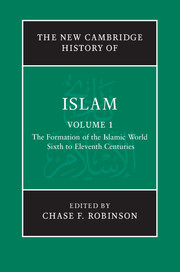Book contents
- Frontmatter
- Introduction
- PART I THE LATE ANTIQUE CONTEXT
- PART II UNIVERSALISM AND IMPERIALISM
- 5 The rise of Islam, 600–705
- 6 The empire in Syria, 705–763
- 7 The empire in Iraq, 763–861
- 8 The waning of empire, 861–945
- 9 The late ʿAbbāsid pattern, 945–1050
- PART III REGIONALISM
- PART IV THE HISTORIOGRAPHY OF EARLY ISLAMIC HISTORY
- Conclusion: From formative Islam to classical Islam
- Glossary
- Bibliography
- Index
- Plate Section
- References
6 - The empire in Syria, 705–763
from PART II - UNIVERSALISM AND IMPERIALISM
Published online by Cambridge University Press: 28 March 2011
- Frontmatter
- Introduction
- PART I THE LATE ANTIQUE CONTEXT
- PART II UNIVERSALISM AND IMPERIALISM
- 5 The rise of Islam, 600–705
- 6 The empire in Syria, 705–763
- 7 The empire in Iraq, 763–861
- 8 The waning of empire, 861–945
- 9 The late ʿAbbāsid pattern, 945–1050
- PART III REGIONALISM
- PART IV THE HISTORIOGRAPHY OF EARLY ISLAMIC HISTORY
- Conclusion: From formative Islam to classical Islam
- Glossary
- Bibliography
- Index
- Plate Section
- References
Summary
Introduction
Syria is usually where empires end, not where they begin. Throughout its long history the region between the Euphrates and the Mediterranean has been a theatre for imperial designs concocted elsewhere: in Babylon, Rome, Constantinople, Cairo. After the collapse of the Seleucid state (323–64 BCE), only once, and only briefly, did Syria itself serve as the metropole to an empire. Like its Seleucid ancestor, the Marwānid experiment in Syria showed that a far-flung Middle Eastern empire was still possible without Iraq or Egypt to serve as its centre. Yet without the intensively harvested revenues of the Nile Valley and Mesopotamia and the military and cultural production they allowed, the Marwānid caliphate would not have lasted as long as it did. And if the Seleucid empire was a successor state to Alexander’s Hellenistic venture, then the Marwānid reprise must be reckoned a precursor state. Providing as it did the framework in which Islam and Arabic culture spread beyond the Nile-to-Oxus core of the caliphate, the Marwānid caliphate set Islamic civilisation on course to be fully realised by other polities. Greater in size if not duration than the Seleucid empire, the Marwānid caliphate gave Islamic Syria its place, however fleeting, in the sun.
Keywords
- Type
- Chapter
- Information
- The New Cambridge History of Islam , pp. 226 - 268Publisher: Cambridge University PressPrint publication year: 2010
References
- 2
- Cited by



